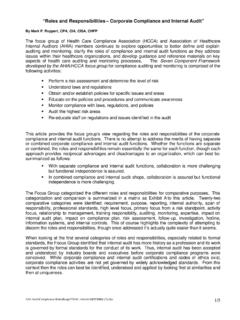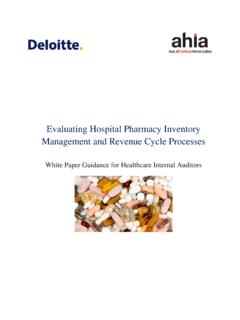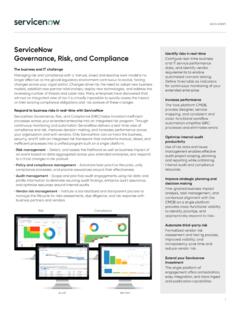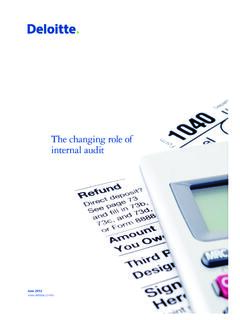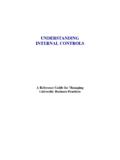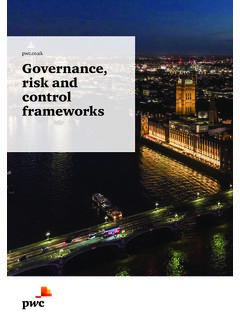Transcription of Performing a Compliance Risk Assessment for Compliance ...
1 - 1 - Performing a Compliance Risk Assessment for Compliance Auditing & Monitoring in Healthcare Organizations Author: Glen C. Mueller, Chief audit & Compliance Officer, Scripps Health, San Diego, CA Introduction A focus group of Health Care Compliance Association (HCCA) and Association of Healthcare Internal Auditors (AHIA) members has been meeting to explore opportunities to better define and explain auditing and monitoring, clarify the roles of Compliance and internal audit functions as they address issues within their healthcare organizations, and develop guidance/materials on key aspects of healthcare auditing and monitoring processes. One of the key HCCA/AHIA team initiatives is to use the Seven Component Framework as a guide in considering the important components of a comprehensive auditing and monitoring process. The Seven Component Framework for Compliance auditing and monitoring is comprised of the following: Perform a risk Assessment and determine the level of risk Understand laws and regulations Obtain and/or establish policies for specific issues and areas Educate on the policies and procedures and communicate awareness Monitor Compliance with laws, regulations, and policies audit the highest risk areas Re-educate staff on regulations and issues identified in the audit This article examines the process of Performing a Compliance risk Assessment and evaluating the level of risk as a means to assist Compliance and internal audit functions in determining where to most effectively focus their auditing and monitoring efforts.
2 In addition, this article discusses the benefits of organizations establishing an ongoing Enterprise Risk Management (ERM) process to facilitate better understanding and identification of risks by a cross-functional team. It is the second in a series of articles being prepared by the HCCA/AHIA auditing & monitoring focus group. Risk Assessment and Evaluation The responsibility for collecting, assessing, and evaluating the broad spectrum of risk Assessment relevant information is generally the responsibility of multiple individuals and different functions throughout the organization. To effectively understand the aggregate relationships and implications of the information identified, most organizations would benefit from some form of an Enterprise Risk Management process to provide for a group think and from a full set of perspectives to assess relevant risks , understand inter-relationships of risk indicators, and determine risk mitigation and control activities.
3 - 2 - The recently released Committee of Sponsoring Organizations (COSO) Enterprise Risk Management model elaborates on the following advantages of a more comprehensive and process view of risk management: Takes note of interrelationships and interdependencies among risks . Offers improved ability to manage risks within and across business units. Improves capacity to identify and seize opportunities inherent in future events. Considers risk in the formulation of strategy. Applies risk management at every level and unit of an entity. Facilitates communication by providing a common risk language. Takes a portfolio view of risks throughout the enterprise. The new COSO ERM model specifies eight components for an ongoing process that include Internal Environment, Objective Setting, Event Identification, Risk Assessment , Risk Response, Control Activities, Information and Communication, and Monitoring. The American Society for Healthcare Risk Management (ASHRM) has also recently formalized an ERM Framework and restructured its 2004 edition of the Risk Management Handbook for Healthcare Organizations around this concept.
4 ASHRM subscribes to the basic tenet that risks do not exist or behave in isolation but can be identified, grouped, and catalogued in risk domains . The six risk domains of the ASHRM framework are Strategic, Operational, Financial, Human Capital, Legal and Regulatory, and Technology. Organizations should evaluate the COSO and ASHRM Enterprise Risk Management frameworks as guidelines and resources for how to establish a process that makes sense for the organization and establish an ERM program that builds on and pulls together existing processes for a more coordinated Assessment of risks . Absent a formalized ERM process, the Chief Compliance Officer and Chief audit Executive should annually co-sponsor a risk Assessment process, including others in key risk related roles, to facilitate the development of their respective annual plans from a risk-based perspective. Completing this process should result in an improved Compliance risk Assessment and provide for a more informed approach on how best to utilize both Compliance and internal audit resources.
5 This article identifies and elaborates on the following phases of risk Assessment and evaluation: Determine the Scope and Preliminary List of Compliance risks to be Assessed Identify Your Organization s Key Compliance Risk Related Data Finalize Set of risks to be Assessed Evaluate Control Activities and Level of Risk Mitigation Calculate Risk Concern Level and Rank Risk Areas Confirm Risk Evaluation Results with Senior Management and Compliance Committee Prepare Performance Improvement Action Plan - 3 - Review Compliance Risk Assessment Results with Board Oversight Committee Incorporate Risk Assessment Results into Compliance and Internal audit Planning Determine the Scope and Preliminary List of Compliance risks to be Assessed Start a Compliance risk Assessment process by determining an initial list of Compliance risks to be assessed, as this will facilitate identification of risk related data to be gathered and evaluated.
6 This initial list of risks will likely be expanded after reviewing a variety of Compliance risk related data such as that shown in the next section. Declaring the intended scope of risks to be considered early in the process provides notice to senior management and the board of directors as to what is not being considered. Examples of fifteen categories/types of Compliance risks that might be included in a Compliance risk Assessment are as follows: 1. Not complying with requirements of a Corporate Integrity Agreement or Settlement. 2. Using an excluded physician, employee, or vendor. 3. Submitting a claim to a government payor for a service not medically necessary. 4. Submitting a claim to a government payor for a service not performed. 5. Submitting an inaccurate or inadequately documented claim to a government payor. 6. Making improper payments to physicians. 7. Failing to timely and accurately meet external reporting requirements.
7 8. Not complying with HIPAA Privacy regulations. 9. Not complying with HIPAA Security regulations. 10. Not evaluating or considering relevancy of OIG Annual Work Plan components. 11. Improper handling and disposal of hazardous waste. 12. Not complying with Human Subjects Protection requirements for clinical trials. 13. Inadequate reporting and monitoring of conflicts of interest. 14. Not completing prior years plan for Compliance auditing and monitoring. 15. Individuals voicing Compliance concerns directly to OIG or media, instead of Compliance . - 4 - Identify Your Organization s Key Compliance Risk Related Data One of the important tasks in Performing a Compliance risk Assessment is to identify relevant sources of information to be considered in determining your organization s business units, departments, processes, and information systems that represent the highest Compliance risk to your organization. Risk related data sources and measures can be thought of in terms of the following nine broad categories of information.
8 Revenue Cycle Information (with focus on government payors) Surveys / Independent Feedback on Operations Events Metrics Financial Metrics Insurance and Lawsuit Claims External Reviews Strategic Plans Technology risks Corporate-wide Performance Dashboards Traditionally Compliance functions have focused on only a subset of the Revenue Cycle metrics and information. Our focus group believes it is essential to evaluate a fuller set of enterprise-wide risk data, as outlined below, since many can have a direct impact on the Assessment of relative Compliance risks . For example, when you combine the metrics of department turnover with Medicare/Medicaid percentage of total revenue by department, those departments with the profile of high turnover / high percentage of Medicare/Medicaid revenue have a higher Compliance risk due to greater likelihood of temporary and new staff not being as familiar with policies and procedures, possible disgruntled whistleblower staff, and increased opportunity for errors.
9 We suggest over forty types and sources of information, to be considered in a Compliance risk Assessment , which should be supplemented with additional information specific to your organization. Revenue Cycle Information (with focus on government payors) OIG Annual Work Plan related initiatives Degree of Compliance with corporate integrity agreement requirements Billing claims denials by department Medicare/Medicaid percentage of total revenue by department Coding accuracy statistics and trends Trends in government payor mix by department and specialty Utilization reports by DRG and CPT codes Physician billing - Medicare Development Letters Results of reviews by Fiscal Intermediary or other reviewers Government payor credit balances / trends Internal audits and Compliance reports and status of corrective actions - 5 - Surveys / Independent Feedback on Operations Patient satisfaction surveys/polls Employee satisfaction surveys/polls Physician satisfaction surveys/polls Periodic survey/interviews of senior management as to greatest risks Events Metrics Occurrence reporting (patient care and employee safety statistics)
10 Compliance Hot-line calls Compliance issues reported directly to Compliance and internal audit Adverse Drug Events statistics Patient complaints logs Staff turnover by department Sick time/absenteeism by department Percentage of traveler and registry nurses vs. full time employees Number of clinical trials/protocols Financial Metrics YTD budget variances by business unit and department Sarbanes Oxley Section 404 Internal Controls Review Action Plan Overtime by department Liquid assets (cash, inventory) by department Amount of Federal grants & contracts included in A-133 audit Amount of contract staff versus employed staff Insurance and Lawsuit Claims Worker compensation claims by department Crime-theft policy claims Property damage claims Medical malpractice claims Lawsuits by department External Reviews Consultants reports Feasibility studies Surveys by state regulatory agencies JCAHO reviews Independent auditor s (CPA Firm)

